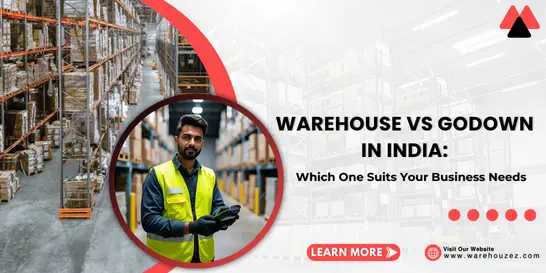The Benefits of On-Demand Warehousing for Businesses: A Comprehensive Guide
The Benefits of On-Demand Warehousing for Businesses: A Comprehensive Guide
In today's dynamic marketplace, there's an ever-growing need for efficient and flexible warehousing solutions. Moreover, with the rise of e-commerce and fluctuating consumer preferences, businesses are seeking innovative ways to optimize their supply chain operations. In this regard, on-demand warehousing emerges as a versatile solution for businesses across industries, reshaping the way companies manage their inventories. It works as a pay-as-you-go model, providing benefits of cost-effectiveness, convenience, flexibility, and scalability. Clients only pay for the space they require while enjoying access to industry-leading technologies and resources.
In this particular blog post, we will explore the myriad benefits that on-demand warehousing brings for businesses of all sizes and types. So, let's get started!
Introduction to On-Demand Warehousing: What It Is and How It Works
At its most basic, on-demand warehousing is a strategic solution that allows businesses to access storage space on a flexible, as-needed basis. In this model, companies only pay for the storage space and warehouse services they use, adopting a "pay as you use" structure. This means that companies can efficiently manage their inventories without any fixed commitments, heavy investments, or long-term leases. This model enables businesses to scale their operations while adapting to fluctuating demand without any financial constraints.
On-demand warehousing solutions include various services, such as inventory management, transportation, and order fulfillment. 3PL warehousing companies usually have a network of well-established warehouses in India, enabling businesses to use these spaces whenever they require extra capacity. Additionally, these 3PL companies have the latest technology, like WMS software, that connects clients with available warehouse space, providing real-time visibility into inventory levels and order statuses.
Factors Driving the Demand for Flexible Warehousing Solutions in India
The demand for on-demand warehousing solutions in India has been higher than ever before. Factors like ever-expanding e-commerce, evolving customer expectations, and rapid urbanization are driving the need for flexible and scalable storage solutions.
Let's learn more about these key driving factors:
1. E-commerce Growth
The growing popularity of online shopping is a primary driver for the demand for flexible storage solutions. With the ever-expanding e-commerce sector, online businesses require adaptable storage options to manage inventory levels and fulfill orders quickly. On-demand warehousing offers a scalable solution, allowing online businesses to adjust their storage needs based on seasonal demand peaks or promotional events without any fixed costs.
2. Fluctuating Demand
The dynamic nature of India's industries further necessitates the need for flexible warehouse services. This as-per-needed or pay-as-you-go model caters to the varying needs of businesses, enabling them to scale their storage space up or down based on changing market demands. This flexibility ensures that companies can optimize their operational costs without being constrained by fixed, long-term leases during periods of lower demand.
3. Rapid Urbanization and Space Constraints
The major Indian cities are undergoing rapid urbanization, leading to higher real estate costs and space constraints. On-demand warehousing addresses these challenges by offering businesses the option to access strategically located storage facilities. This proximity not only reduces transportation costs but also enhances the efficiency of last-mile deliveries, aligning with the demands of the urban-centric consumer base.
The Top Benefits of On-Demand Warehousing for Businesses
The benefits of on-demand warehousing are countless, ranging from cost savings to increased efficiency and flexibility.
Let's take a look at the benefits of this revolutionary model:
1. Access to a Vast Network of Warehouses
One of the most significant benefits of flexi-warehousing is access to a vast network of warehouses. This innovative model provides businesses with access to an extensive network of storage facilities strategically located across different regions. This way, companies can store their products closer to the end consumer, reducing transportation costs. It also allows businesses to tap into the state-of-the-art infrastructure, technology, and resources of the warehouse while paying only for the space they use and expanding it whenever required.
2. Cost-Efficiency and Reduced Operational Costs
The pay-as-you-go model of on-demand warehousing can certainly translate into significant cost savings for companies. Instead of committing to fixed, long-term leases, companies pay only for the storage space and services they actively use. This flexibility not only reduces financial burden but also allows businesses to optimize their operational costs, allocating resources more efficiently based on real-time demand and market conditions.
3. Improved Inventory Management
Businesses can significantly benefit from improved inventory management through flexible and scalable storage solutions. The flexibility to scale storage space allows them to align with fluctuations in demand, preventing overstocks or stockouts. With real-time data and analytics, companies can optimize stock levels, reduce holding costs, and improve order accuracy. This efficient inventory management ensures that businesses can meet customer demands promptly and maintain a lean, responsive supply chain.
4. Faster Order Fulfillment and Shipping
By utilizing on-demand warehouse services, businesses can facilitate faster order fulfillment and shipping, which is certainly a crucial factor in meeting customer expectations. By strategically storing inventory in proximity to their customer base and target market, businesses can reduce lead times and expedite order processing. This quick fulfillment not only enhances customer satisfaction but also allows businesses to remain competitive in today's fast-paced market. All these aspects together contribute to overall customer loyalty and positive brand perception.
5. Flexibility and Scalability
On-demand warehousing introduces greater levels of flexibility and scalability previously unavailable with traditional storage models. Businesses can dynamically adjust their storage needs based on changing demands, seasonal fluctuations, or market expansions. This flexibility ensures that companies neither overcommit to excessive space nor face limitations during peak periods, ultimately optimizing operational efficiency.
6. Profitability and Revenue Growth
Adopting on-demand warehousing positively impacts a company's profitability and significantly contributes to sustained revenue growth. The pay-as-you-go model means that companies only pay for the storage space they use, eliminating unnecessary expenses associated with underutilized space. This efficient cost structure empowers businesses to allocate resources more strategically, directing savings towards innovation, technology, marketing initiatives, or other areas that directly contribute to revenue generation and overall financial health. Consequently, this flexible model becomes a key enabler of more profitable and sustainable business growth.
Bottom Line
To offer concluding remarks, the adoption of on-demand warehousing solutions marks a significant shift in how businesses manage their inventory and fulfill orders. There are myriad benefits to this innovative model, including flexibility, scalability, supply chain resilience, and profitability. This modern approach to warehousing certainly serves as a catalyst for success in today's dynamic business landscape. As companies strive for greater adaptability and efficiency, this transformative approach offers a strategic solution to navigate challenges, seize opportunities, and optimize resources. By embracing the advantages of on-demand warehousing services, businesses can not only meet the demands of a rapidly evolving market but also pave the way for sustained growth and competitiveness. So, in an era where agility, cost-effectiveness, and flexibility are imperative, on-demand warehousing stands out as the best solution for businesses to succeed and thrive.



